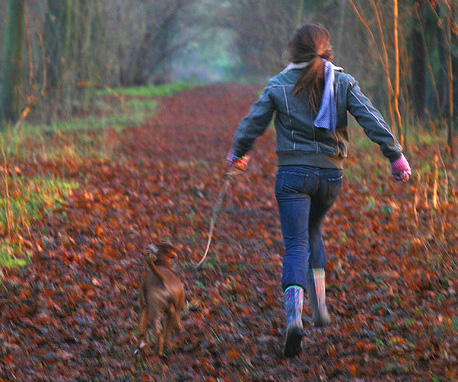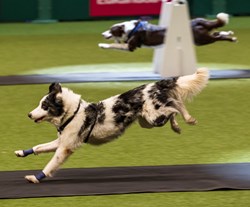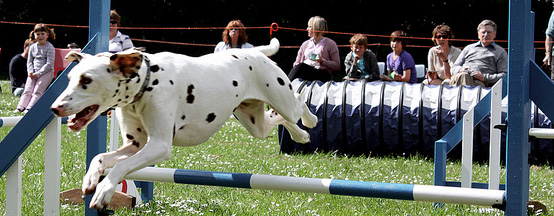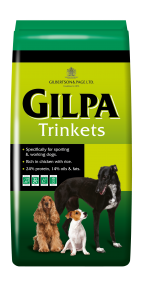We Need More Exercise … and so do Many of our Dogs
31/01/2014
All responsible dog owners understand the importance of exercise for their dog; it keeps them fit, healthy, mentally stimulated and happy. On wet, grey winter days sometimes the thought of getting togged up and heading out into the damp and gloom to take the dog for a walk is unappealing to say the least. If you and your pet are also getting a bit fed up of doing the same walks on the same routes, maybe you could do with taking a fresh look at the ways you and your dog exercise together. Let’s face it, needing to exercise your dog is a great excuse to get some exercise yourself.
Dogs are naturally active and not suited to sedentary lifestyles. In the wild they would be out hunting for food, socializing in a pack and exploring their territory. Simply putting a dog out in a yard does not constitute exercise. They need human interaction too. Dogs that don’t get enough exercise end up unhealthy, overweight and often develop behavioural problems, such as digging, scratching, chewing, biting, jumping up, barking, whining and excessive night-time activity. Dogs that get plenty of exercise are healthier, have fewer digestive and behavioural problems, sleep better at night and are more restful in the home.
Every dog needs exercise, but how much depends on the size and breed of dog. Whilst it can generally be said that smaller dogs need less exercise, this is not a hard and fast rule because some small toy dogs will only need a quick walk to the shops each day to receive enough exercise, whereas other small dogs, such as terriers and jack russells need considerably more exercise and stimulation. Larger dogs that are bred to put in a long day’s work, such as sheep dogs, retrievers, larger breeds of spaniel and huskies, need huge amounts of exercise and mental stimulation; two or more long walks a day alongside fetch and nosework.
Age and general health will also have an affect on the amount of exercise you can expect from your dog. It is advisable to check with your vet if you think your dog has a condition which may affect how much and what type of exercise it can do. Your vet will also be able to give a rough guideline for how much exercise your dog should have. Working out whether your dog is getting enough exercise doesn’t have any definite rules. During exercise your dog should be panting, this shows that their heart rate has increased and they are getting a good workout. However, they should not be wheezing. After exercising, your pooped out pooch will mostly likely want a rest and a good drink of water. If they show any signs of injury – limping, reluctance to get up, walk or jump – following a good rest, then this is a sign they need to take it steadier next time, particularly if they are an older dog, and you may need a trip to the vet. Over time keeping an eye on the weight of your dog and checking their condition are good indicators of whether they are exercising effectively. You can read more about feeding to condition here.
Here are some exercise ideas that you may like to consider:
- Agility classes – Running, jumping through hoops and over hurdles, balancing on walkways and crawling through tunnels are just some of the fun and varied exercises you can expect your dog to learn at agility classes. If you find yourselves competing in competitions there are some excellent prizes up for grabs too.
- Heelwork to Music and Dancing – Learning a dance routine with your dog not only exercises both of you physically and mentally, but also creates a great bond and is lots of fun. You can indulge your competitive side here too, by entering competitions both locally and nationally.
- Flyball – This fast-paced activity involves a dog relay team which works together at speed. A dog must run down a course, jumping over hurdles along the way. At the end it pushes a button with its paws to release a ball which it catches and races back to the start, whereupon the next dog in the relay sets off. It provides great physical and mental stimulation for dogs and encourages their socialising skills with other dogs as well as their bond with their owner.
- Fetch and Nosework – Make fetch more interesting and fine tune your dog’s senses at the same time by gradually training them to follow a scent. Start off with their usual treat hidden in a familiar toy which you hide somewhere close by and work up to more complicated things. You’ll be amazed at what they can learn and they’ll receive essential mental stimulation.
- Hiking – Are your daily walks getting a bit same old same old? Take a different route and explore more of your local area by going hiking. Pack a day bag with waterproofs, flask, water for your furry friend, snacks for you both and a map and compass and see some different scenery.
- Running and Fell Running – If you like jogging or have always fancied taking it up, then this could be the perfect time for you and your dog to get some exercise. Once you’ve caught the running bug, you might like to take it a step further by heading out into the countryside to try fell running. You and your dog may need frequent breaks at first to rest and take on water and it’s a good idea to start with short runs and build up gradually. Also your dog will probably prefer to run on grassy terrain, which will be more comfortable on its paws.
- Water Exercise – Build up your dog’s water confidence slowly with trips to a stretch of safe water with a gradual sloping entry and exit, where you can paddle too. As their confidence grows encourage them to go out a little further by playing fetch. Take your own supply of water for your dog to drink to discourage it from drinking unclean water.
After exercising it is important to provide an opportunity to rest, plenty of fresh water, a treat and positive attention. It is also important to make sure their dog food is nutritionally balanced and will provide enough energy for the dog’s daily exercise whilst simultaneously including vital vitamins, minerals and supplements to maintain overall good health and promote good bone, joint, ligament and muscle health. Gilpa Trinkets, Heritage Adult and Dr John Titanium are all complete, premium dog foods for adult dogs that get plenty of exercise. They contain a good source of protein, in the form of chicken and other poultry, and carbohydrate in the form of grain and rice. Essential fats and oils, including omega 3 and 6, keep skin and coat well nourished and aid brain development. New Zealand green lipped mussel extract is a natural source of glucosamine for healthy joints, while manganese aids ligament health. Vitamins and minerals support the immune system, organ function and good eyesight.
As with humans you get out what you put in; a dog that is well cared for and healthy will be ready for anything and enthusiastic about exercise. Similarly a dog that gets plenty of exercise will eat well and be fit and healthy. Exercising with your dog will improve the health and fitness of both of you, as well as strengthening your bond. Whether you opt for exploring the splendour that the British countryside has to offer or the upbeat, busy teamwork of a flyball club, get out and get fit with your canine buddy today.






